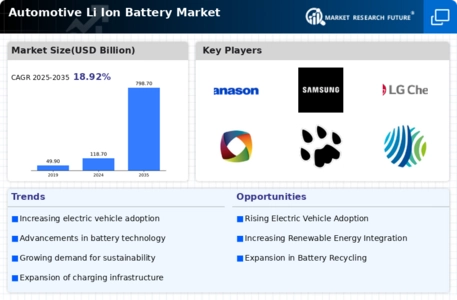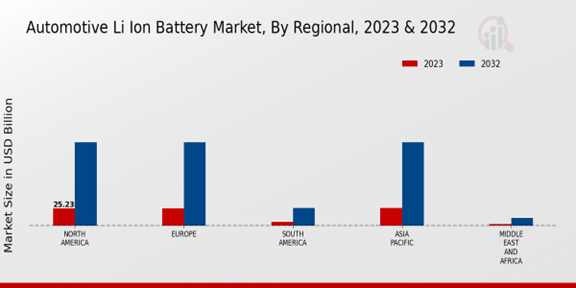Market Growth Projections
The Global Automotive Li Ion Battery Market Industry is poised for remarkable growth, with projections indicating a substantial increase in market value. In 2024, the market is expected to reach 118.7 USD Billion, with a forecasted surge to 798.7 USD Billion by 2035. This growth trajectory reflects a compound annual growth rate (CAGR) of 18.92% from 2025 to 2035, highlighting the increasing reliance on Li Ion batteries in the automotive sector. The anticipated expansion is driven by various factors, including rising electric vehicle adoption, technological advancements, and supportive government policies.
Government Policies and Incentives
Government policies and incentives play a crucial role in shaping the Global Automotive Li Ion Battery Market Industry. Many countries are implementing stringent emissions regulations and offering financial incentives to promote the adoption of electric vehicles. These initiatives encourage manufacturers to invest in Li Ion battery technology and production. For instance, subsidies for EV purchases and tax breaks for manufacturers are becoming commonplace. Such supportive measures are likely to drive market growth, as they not only stimulate consumer interest but also facilitate the establishment of a robust supply chain for battery production.
Rising Demand for Electric Vehicles
The increasing global demand for electric vehicles (EVs) is a primary driver of the Global Automotive Li Ion Battery Market Industry. As consumers become more environmentally conscious, the shift towards sustainable transportation solutions accelerates. In 2024, the market is projected to reach 118.7 USD Billion, largely fueled by government incentives and regulations promoting EV adoption. This trend is expected to continue, with the market potentially expanding to 798.7 USD Billion by 2035. The compound annual growth rate (CAGR) of 18.92% from 2025 to 2035 indicates a robust growth trajectory, underscoring the pivotal role of Li Ion batteries in the automotive sector.
Expansion of Charging Infrastructure
The expansion of charging infrastructure is vital for the growth of the Global Automotive Li Ion Battery Market Industry. As electric vehicle adoption rises, the need for accessible and efficient charging solutions becomes paramount. Governments and private entities are investing heavily in the development of charging networks to alleviate range anxiety among consumers. This expansion not only supports the current market but also encourages potential buyers to consider electric vehicles. The establishment of fast-charging stations and widespread availability of charging points is likely to enhance the overall market environment, fostering a conducive atmosphere for Li Ion battery growth.
Growing Focus on Renewable Energy Integration
The growing focus on renewable energy integration is another significant driver of the Global Automotive Li Ion Battery Market Industry. As the world transitions towards cleaner energy sources, the demand for energy storage solutions, including Li Ion batteries, is increasing. These batteries are essential for storing energy generated from renewable sources such as solar and wind. The synergy between electric vehicles and renewable energy systems enhances the appeal of Li Ion batteries, as they can serve dual purposes. This trend is expected to contribute to the market's expansion, aligning with the projected growth rates in the coming years.
Technological Advancements in Battery Technology
Technological advancements in battery technology significantly influence the Global Automotive Li Ion Battery Market Industry. Innovations such as improved energy density, faster charging times, and enhanced safety features are driving the development of next-generation batteries. Manufacturers are investing in research and development to create batteries that not only meet the growing demands of EVs but also reduce costs. These advancements are likely to enhance the performance and longevity of Li Ion batteries, making them more appealing to consumers. As a result, the market is expected to witness substantial growth, aligning with the projected increase in demand for electric vehicles.





















Leave a Comment